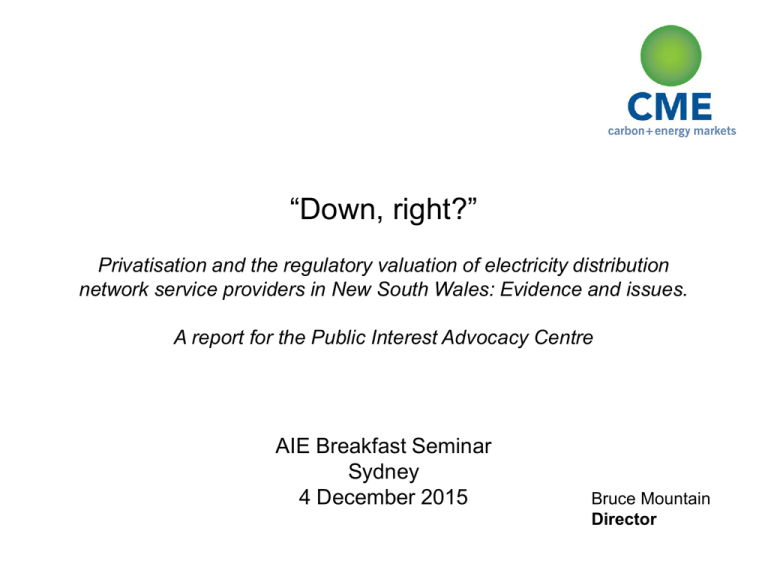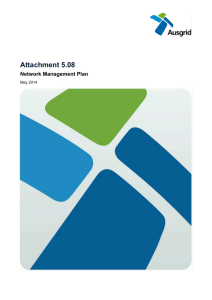“Down, right?” Privatisation and the regulatory
advertisement

“Down, right?” Privatisation and the regulatory valuation of electricity distribution network service providers in New South Wales: Evidence and issues. A report for the Public Interest Advocacy Centre AIE Breakfast Seminar Sydney 4 December 2015 Bruce Mountain Director Outline • Context – – – – Prices Regulated revenues Regulatory asset valuations Market versus regulatory asset valuations • Evidence of stranded assets • Quantification of possible revaluation • Is revaluation before privatisation necessarily a bitter pill? • Next steps 2 Network prices in NSW are high, after AER Draft Decision Source: AER Draft Decision, Ofgem RIIO ED1 proposals, OECD (for PPP exchange rates), CME analysis 3 Regulated revenues per connection in NSW do not compare favourably Regulated revenue per connec on 2002 $ (2013) 2013 $2,000 $1,800 $1,600 $1,400 $1,200 $1,000 $800 $600 $400 $200 $Ergon Energy Essen al Energy Ausgrid Endeavour Aurora Energy Source: regulatory decisions, CME analysis 4 Energex SA Power SP Ausnet Powercor Ci power Networks Jemena United Energy Regulatory asset valuations in NSW 2-2.5X those in VIC per connection Regulated assets per connec on (PPP exchange rates) $ per connec on $10,000 $9,000 $8,000 $7,000 $6,000 $5,000 $4,000 $3,000 $2,000 $1,000 $Avg in GB (2016) SA (2013) VIC (2013) Regulatory decisions, CME analysis 5 TAS (2013) NSW (2013) Endeavour (2015) Essen al (2015) AusGrid (2015) QLD (2013) Market vs regulatory asset valuations ? $7,000 Great Britain Victoria $6,000 $(thousands) (2013) per connec on NSW $5,000 $4,000 $3,000 $2,000 $1,000 $- RAB per connec on at priva sa on (2013 AUD) Market valua on per connec on at priva sa on (2013 AUD) Sources: CME analysis with data from www.statisticsauthority.gov.uk (British RPI), www.rba.gov.au (Australian CPI), Grout et al. (2004), (Grout and Jenkins, 2001, Domah and Pollitt, 2000) (GB market values and customer numbers), www.aer.gov.au (Regulatory Information Notices for NSW regulatory asset values), Victorian market value and 6 regulatory asset values (Quiggin, 2002), GB regulatory asset values (Office of the Electricity Regulator, 1999). Is stranding: a real concern? GWh through-put RAB per MW of average demand 7 AEMO’s changing forecast of total electricity consumption in NSW in 2014/15: When will AEMO under-forecast demand? 8 AEMO projects that NSW rooftop PV capacity will account for a quarter of NSW peak demand in 15 years time 25% 20% 15% 10% 5% 0% 2013 9 2015 2017 2019 2021 2023 2025 2027 2029 Average demand divided by installed transformer capacity: high and rising capacity margins 10 $(thousands) per connec on (2013) $7 $6 $5 $2.3 VIC $3.5 $4 $3 $2 $1 $3.8 $2.6 $Opening (1 Jan 2000) Addi ons Indexa on less deprecia on and disposals Closing (31 Dec 2012) $(thousands) per connec on (2013) $12 $10 $3.6 $8 NSW $6.8 $6 $4 $6.5 $2 $3.3 $Opening (1 July 2000) 11 Addi ons Indexa on less deprecia on and disposals Closing (30 June 2013) Is a write-down necessarily a bitter pill? • Current owner averse to write-downs, but future owners don’t like risk of future write downs. Assurances by politicians at privatisation that assets will not be written-down in future may provide some protection. • But banking on future political will to underwrite stranding risk in a fading monopoly is not particularly desirable. • Therefore asset write-down before privatisation likely to be counted more highly than political assurances: a bird in the hand is worth two in the bush. • This may result in more vigorous investor competition at privatisation, and hence higher RAB multiples. Following this logic, a lower regulatory valuation need not translate into lower privatisation proceeds: 12 Next steps • Find out what prospective buyers think. Are they worried about stranding risk and will a pre-privatisation revaluation be counted more highly than politicians’ assurances? • Extend analysis to the rest of the NEM - underway. • Think about the best way to write down: – Once-off write-down; – Differentiated rate of return for sunk v new investment; – Escrow account for stranded assets, with opportunity to write-back if assets later become “used and useful”; – Accelerated depreciation; – Ending CPI indexation of stranded sunk assets. – Many others and combinations of above. 13






